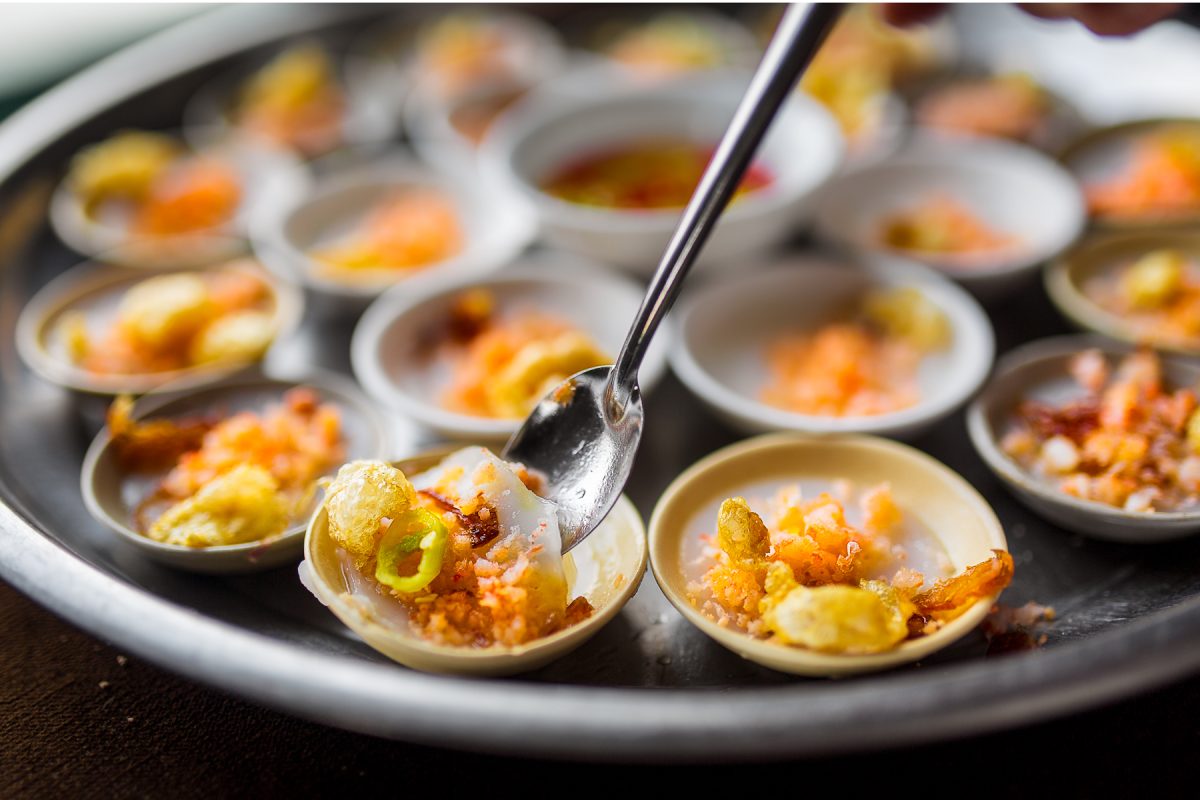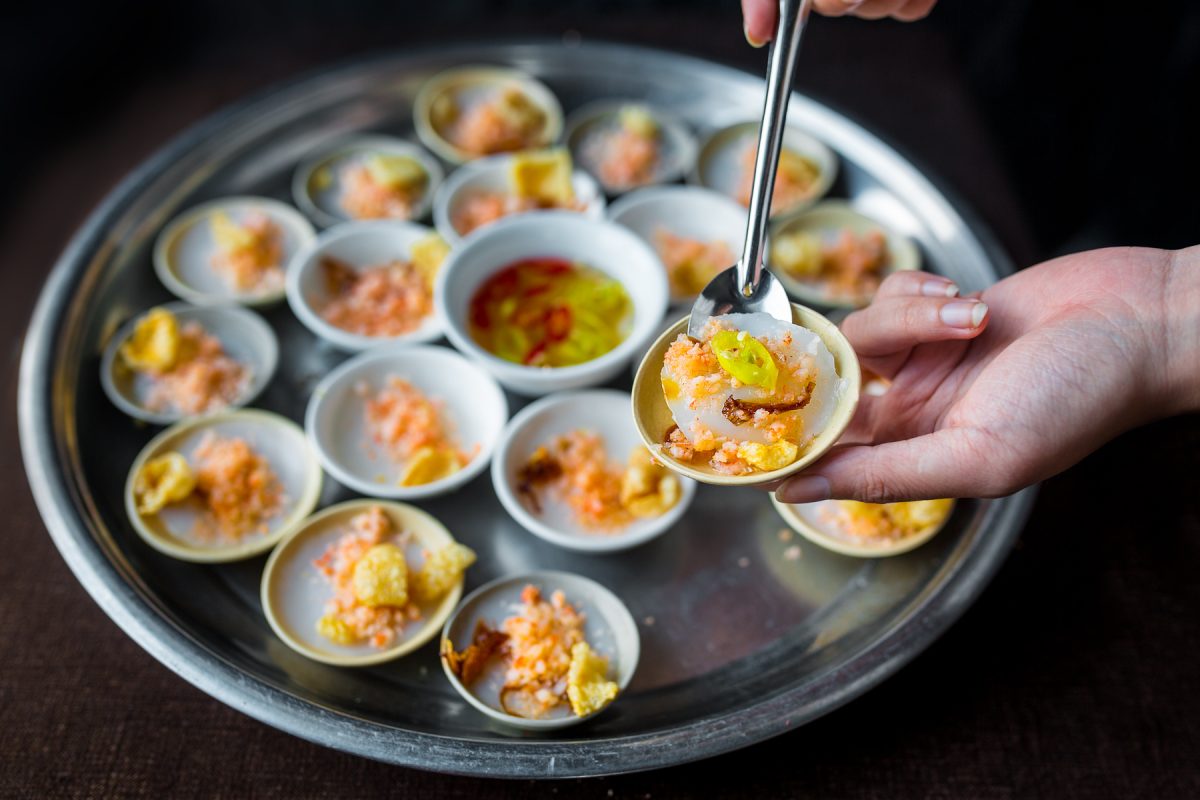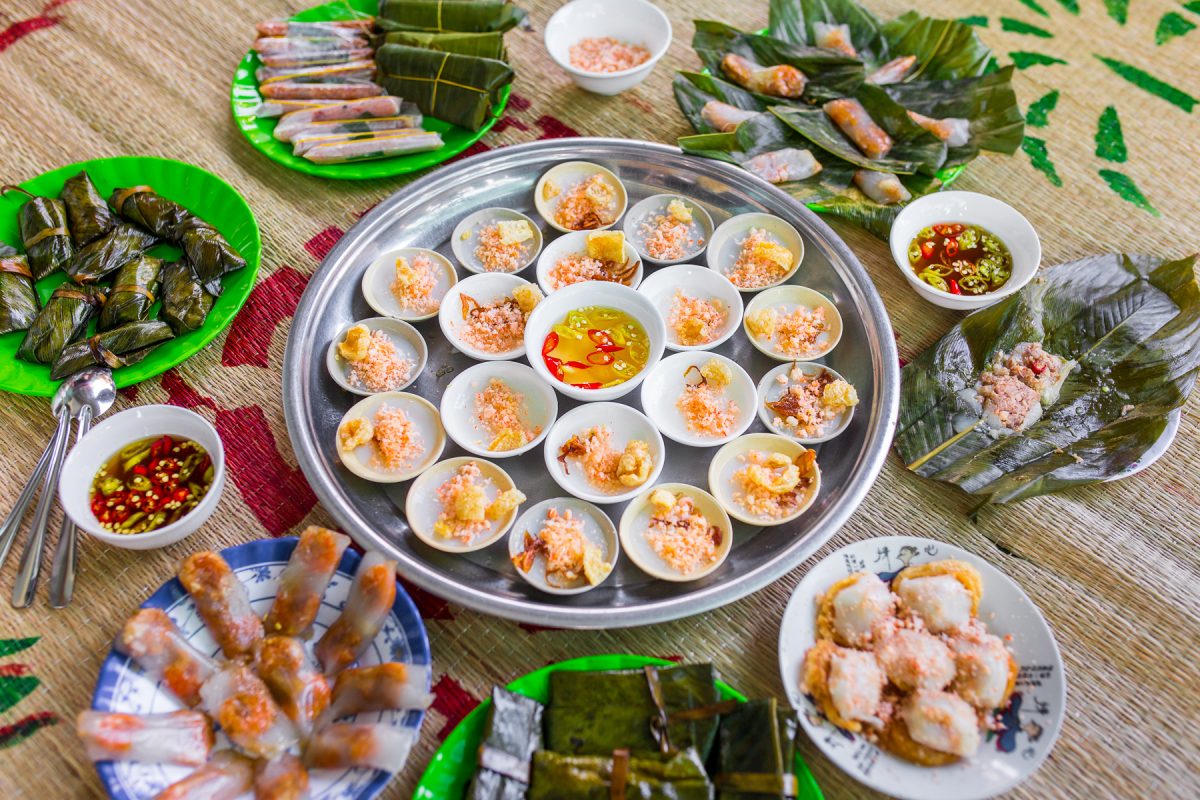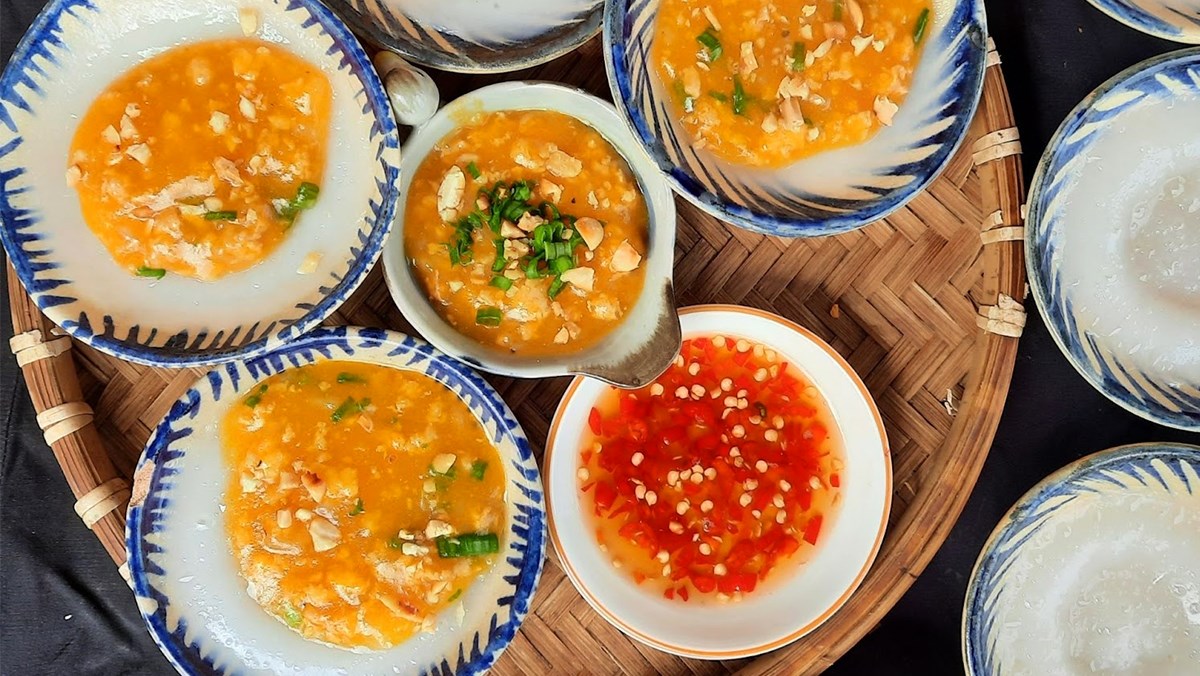Introduction to Steamed Shrimp Rice Cake Hue
Steamed shrimp rice cake, known as bánh nậm in Vietnam, is a delicate and flavorful dish that embodies the culinary artistry of Hue, the former imperial capital of Vietnam. This savory delicacy, wrapped in banana leaves and steamed to perfection, is a staple of Hue’s rich food culture, reflecting the region’s history, meticulous craftsmanship, and reverence for balance in flavors. Often enjoyed as a snack or appetizer, bánh nậm combines simple ingredients—rice flour, shrimp, and spices—into a harmonious bite that tells a story of Hue’s royal past and resilient spirit. This article explores the history, ingredients, and cultural significance of steamed shrimp rice cake Hue, delving into the stories behind its creation and its enduring appeal, while highlighting the authentic Vietnamese culinary experiences offered by VietRice Essence Restaurant and Viet Rice Kitchen Cooking Class in Hanoi.

Historical Roots of Steamed Shrimp Rice Cake Hue
Origins in Hue’s Imperial Era
Hue, located in central Vietnam, served as the capital of the Nguyen Dynasty from 1802 to 1945, a period that shaped its refined culinary traditions. Steamed shrimp rice cake, or bánh nậm, emerged during this era, initially as a dish crafted for royalty. The Nguyen court was known for its elaborate banquets, where food was not just sustenance but an expression of artistry and status. Bánh nậm’s delicate presentation and balanced flavors made it a favorite among the imperial elite, served at palace feasts and ceremonial gatherings.
The dish’s origins are tied to Hue’s agrarian roots and the abundance of rice, a staple crop in the Perfume River delta. Local women, skilled in transforming humble ingredients into sophisticated dishes, developed bánh nậm as a portable, flavorful snack. Its banana leaf wrapping, a nod to the region’s lush gardens, preserved freshness and added a subtle aroma, making it ideal for royal outings or offerings at ancestral altars.
Evolution Through Time
As Hue’s imperial influence waned in the 20th century, bánh nậm transitioned from a royal delicacy to a beloved street food, accessible to all classes. During the French colonial period (1887–1945), Hue’s cuisine absorbed subtle influences, such as the use of annatto oil for vibrant color, but bánh nậm retained its core Vietnamese identity. The dish’s simplicity and affordability made it a staple in markets and homes, especially during festivals like Tet (Lunar New Year).
The Vietnam War (1955–1975) and subsequent economic hardships tested Hue’s culinary traditions, yet bánh nậm endured as a symbol of resilience. Street vendors, often women, kept the dish alive, selling it from baskets in Hue’s bustling markets like Dong Ba. Today, bánh nậm is a cultural icon, celebrated in Hue and beyond, with its recipe passed down through generations, as noted in culinary blogs like Slow Travel Hue, which highlight its historical significance.
Archaeological and Cultural Context
While bánh nậm lacks direct archaeological evidence, Hue’s culinary heritage is documented through oral histories and artifacts from the Nguyen Dynasty. Excavations at the Imperial City, a UNESCO World Heritage Site, have uncovered ceramic dishes and kitchen tools, suggesting the sophisticated food preparation techniques of the era. Cookbooks from the 19th century, preserved in Hue’s archives, describe rice-based dishes wrapped in leaves, likely predecessors to bánh nậm. These findings, combined with stories from Hue’s elders, paint a picture of a cuisine shaped by ingenuity and reverence for tradition.

The Ingredients of Steamed Shrimp Rice Cake Hue
Core Components
Bánh nậm is a masterclass in simplicity, using a handful of ingredients to create a complex flavor profile. The key components include:
- Rice Flour: The foundation of the cake, traditionally made from “De” rice, a premium variety from An Cuu village in Hue. The rice is soaked, ground into a fine flour, and mixed with water to form a smooth batter. The batter’s texture is critical—too thick, and the cake becomes heavy; too thin, and it lacks structure.
- Shrimp: Tiny freshwater shrimp from the Perfume River or Tam Giang Lagoon are preferred for their sweet, delicate flavor. The shrimp are ground or minced, marinated with fish sauce, pepper, and scallions, then stir-fried to enhance their umami.
- Banana Leaves: Fresh banana leaves, abundant in Hue’s gardens, are used to wrap the cakes, imparting a subtle, earthy aroma during steaming. The leaves also make bánh nậm portable and visually appealing.
- Seasonings: Fish sauce, annatto oil (for color), shallots, garlic, and scallions add depth and vibrancy. The seasonings are carefully balanced to complement the shrimp and rice without overpowering them.
- Dipping Sauce (Nước Mắm): A sweet-sour-spicy fish sauce, made with lime, chili, garlic, and sugar, is essential for serving. The sauce elevates the cake’s flavors, adding a tangy kick that Hue cuisine is known for.
Preparation Process
Making bánh nậm is a labor of love, requiring patience and precision. The process, as outlined in sources like Serious Eats, involves several steps:
- Batter Preparation: Rice flour is mixed with water and cooked on low heat until it thickens into a gluey paste. Tapioca flour is sometimes added for a silkier texture.
- Shrimp Filling: The shrimp are cleaned, ground, and stir-fried with seasonings and annatto oil until fragrant. Scallions are added for freshness.
- Wrapping: A thin layer of batter is spread onto a banana leaf, topped with a spoonful of shrimp filling, and folded into a rectangular packet. The leaf is secured to hold the contents during steaming.
- Steaming: The packets are steamed for 15–20 minutes, allowing the batter to set into a soft, slightly chewy cake infused with the banana leaf’s aroma.
- Serving: Bánh nậm is served warm, unwrapped from the leaf, with a drizzle of nước mắm and optional chili slices for heat.
This two-stage cooking process—cooking the batter before steaming—ensures the cake’s signature silky texture, distinguishing it from other Vietnamese rice dishes like bánh đúc, a porridge-like dish.
Variations and Regional Influences
While bánh nậm is quintessentially Hue, variations exist. Some recipes, as seen in Madam Thu’s offerings, include ground pork or wood ear mushrooms alongside shrimp, adding heartiness. In southern Vietnam, bánh nậm may be thicker and served without leaves, reflecting regional tastes. Hue’s version, however, remains the gold standard for its delicate balance and imperial refinement.

The Story Behind Steamed Shrimp Rice Cake Hue
A Dish of Modesty and Nobility
Bánh nậm’s story is one of duality—modest in its ingredients yet noble in its execution. Hue’s cuisine, influenced by the Nguyen court, emphasizes intricacy and balance, even in simple dishes. Bánh nậm reflects this philosophy, transforming rice and shrimp into a delicacy fit for emperors. Its banana leaf wrapping, a practical choice for preservation, also carries symbolic weight, representing Hue’s connection to nature and ancestral traditions.
The dish’s accessibility made it a bridge between classes. While royals savored bánh nậm at banquets, peasants enjoyed it as a market snack, sold by vendors carrying bamboo baskets. This democratization, as noted in Explore Vietnam, cemented bánh nậm’s place in Hue’s cultural identity, evoking nostalgia for childhood and simpler times.
Women’s Role in Preserving Tradition
Women have been the custodians of bánh nậm’s legacy. From imperial kitchens to modern street stalls, Hue’s female cooks have perfected the dish, passing recipes through generations. Stories like that of Madam Thu, who learned to make Hue cakes from her mother at a young age, highlight this matriarchal tradition. Their patience in grinding rice, folding leaves, and balancing flavors embodies Hue’s culinary ethos—careful, deliberate, and soulful.
During Vietnam’s economic struggles post-1975, women vendors kept bánh nậm alive, selling it in markets despite scarce resources. Their resilience ensured the dish’s survival, making it a symbol of Hue’s enduring spirit. Today, bánh nậm is celebrated in Hue’s restaurants and festivals, with vendors like those at Dong Ba Market continuing the tradition.
Cultural Significance
Bánh nậm is more than food; it’s a cultural artifact. In Hue, it’s served at family gatherings, temple offerings, and festivals like the Hue Festival, where food stalls showcase the city’s culinary heritage. The dish’s portability makes it ideal for sharing, fostering community bonds. Its presence in Vietnamese diaspora communities, as seen in blogs like RunAwayRice, underscores its global appeal, connecting emigrants to their roots.
The dish also reflects Hue’s environmental harmony. The use of banana leaves, sourced from local gardens, aligns with sustainable practices, while the reliance on river shrimp ties bánh nậm to the Perfume River’s ecosystem. This connection to place makes every bite a taste of Hue’s history and landscape.
The “Show” of Steamed Shrimp Rice Cake Hue
A Sensory Experience
Bánh nậm is a culinary “show” that engages all senses. Visually, the vibrant green banana leaf contrasts with the milky white cake and orange shrimp filling, creating an inviting presentation. The aroma of steamed leaves and savory shrimp wafts through markets, drawing crowds to vendors’ stalls. Texturally, the cake’s soft, chewy bite pairs with the grainy shrimp and sticky rice, while the nước mắm adds a zesty finish. The act of unwrapping the leaf, as described by Slow Travel Hue, is a ritual, enhancing the dining experience with anticipation.
In Hue’s markets, vendors display bánh nậm in woven baskets, their voices calling out to passersby. Street stalls, often family-run, serve the cakes warm, drizzled with fish sauce and garnished with chili, creating a communal atmosphere. Tourists and locals alike gather around, sharing stories over plates of bánh nậm, making it a social as well as culinary event.
Modern Appeal
Today, bánh nậm captivates global foodies, featured in travel blogs and cooking shows for its authenticity and flavor. Its portability and affordability—often costing less than $1 USD per piece—make it accessible, while its imperial pedigree adds prestige. Social media, with Instagram posts of neatly wrapped cakes, has boosted its popularity, drawing travelers to Hue’s Dong Ba Market or restaurants like Madam Thu.
The dish’s versatility also enhances its appeal. It can be a quick snack, a festival treat, or part of a larger Hue banquet alongside other cakes like bánh bèo or bánh lọc. Its vegan-friendly base (rice flour and leaves) allows for adaptations, such as mushroom fillings, broadening its reach.
Culinary Connection to Steamed Shrimp Rice Cake Hue
Hue’s Culinary Landscape
Hue’s cuisine is renowned for its intricacy, with bánh nậm as a prime example. The city’s food culture, shaped by its imperial past and riverine environment, prioritizes fresh ingredients and balanced flavors. Bánh nậm sits alongside other Hue rice cakes, like bánh bèo (steamed rice cakes in small bowls) and bánh ít (sticky rice cakes), each showcasing the versatility of rice. These dishes, often served with nước mắm, reflect Hue’s knack for elevating humble ingredients into art.
Markets like Dong Ba and An Dinh are hubs for bánh nậm, where vendors stack steaming baskets, creating a lively culinary scene. The dish’s preparation, requiring skillful wrapping and steaming, is a performance in itself, drawing crowds to watch artisans at work.
VietRice Essence Restaurant: A Taste of Hue in Hanoi
For those unable to visit Hue, VietRice Essence Restaurant in Hanoi brings the flavors of bánh nậm and Hue’s cuisine to the capital. Located at 93 Phung Hung, Hoan Kiem District, this acclaimed eatery serves authentic Vietnamese dishes, including rice-based delicacies inspired by Hue, such as lotus stem salad, pineapple rice, and vegetarian spring rolls. While bánh nậm itself may not always be on the menu, the restaurant’s focus on fresh, balanced flavors captures the essence of Hue’s culinary philosophy.
VietRice Essence’s cozy ambiance, with attentive staff like Nam and Ms. Nhan, evokes the warmth of Hue’s market stalls. Diners praise the restaurant’s quality, affordability, and complimentary drinks, making it an ideal stop before or after exploring Hanoi’s cultural sites. The restaurant’s commitment to northern and central Vietnamese cuisine connects visitors to the heritage of bánh nậm, offering a taste of Hue’s imperial legacy.
Viet Rice Kitchen Cooking Class: Mastering Hue’s Flavors
To immerse yourself in Hue’s culinary traditions, Viet Rice Kitchen Cooking Class in Hanoi offers a hands-on experience that echoes the artistry of bánh nậm. Held daily from 9:00 AM to 11:00 AM or 2:00 PM to 4:00 PM, these two-hour classes begin with a guided tour of Dong Xuan Market, where participants select fresh ingredients like rice noodles, herbs, and fish sauce, mirroring the markets of Hue.
Under expert chefs, participants learn to prepare dishes like spring rolls, herb-infused chicken, and lotus stem salad, which share the light, aromatic profile of bánh nậm. While the class may not specifically teach bánh nậm due to its specialized preparation, it introduces techniques like steaming and seasoning that are foundational to Hue’s cuisine. The class ends with a shared meal, a complimentary drink, and a video memento, plus recipes to recreate Hue-inspired dishes at home. This experience celebrates Vietnam’s culinary heritage, connecting travelers to the story of bánh nậm and Hue’s food culture.
Comparisons with Other Vietnamese Rice Cakes
Within Hue
- Bánh Bèo: These steamed rice cakes, served in small bowls, are topped with shrimp, mung beans, and pork rinds. Unlike bánh nậm’s leaf wrapping, bánh bèo is open-faced, with a softer texture. Both share Hue’s focus on delicate flavors and fish sauce.
- Bánh Lọc: A translucent dumpling made from tapioca flour, bánh lọc is filled with shrimp or pork and wrapped in banana leaves. It’s chewier than bánh nậm but shares the same steaming technique and regional pride.
Across Vietnam
- Bánh Chưng (Northern Vietnam): A Tet specialty, this square rice cake is made with glutinous rice, mung beans, and pork, wrapped in dong leaves. It’s heartier than bánh nậm and tied to northern agrarian traditions, lacking Hue’s imperial finesse.
- Bánh Tét (Southern Vietnam): A cylindrical version of bánh chưng, bánh tét is similar in ingredients but adapted to southern tastes with sweeter fillings. It contrasts with bánh nậm’s savory, delicate profile.
Bánh nậm stands out for its thin, silky texture and minimalist elegance, a hallmark of Hue’s royal cuisine.

Cultural and Tourism Impact
Preservation and Challenges
Bánh nậm is a cultural treasure, but modernization and tourism pose challenges. As Hue urbanizes, fewer vendors master the labor-intensive art of bánh nậm, and mass production risks diluting its quality. Initiatives like the Hue Cuisine Festival and restaurants like Madam Thu promote traditional recipes, ensuring the dish’s survival. Responsible tourism, supporting family-run stalls, helps preserve Hue’s culinary heritage.
VietRice Essence and Viet Rice Kitchen contribute by showcasing central Vietnamese flavors, educating visitors about dishes like bánh nậm. Their market tours and cooking classes foster respect for Hue’s traditions, encouraging sustainable engagement with its food culture.
Global Appeal
Bánh nậm attracts food enthusiasts worldwide, featured in travel guides and blogs like Serious Eats for its authenticity. Its portability and affordability make it a street food favorite, while its imperial roots add allure for cultural travelers. Hue’s Dong Ba Market, where bánh nậm is sold alongside other cakes, draws millions annually, boosted by social media images of steaming baskets and vibrant leaves.
Practical Tips for Experiencing Steamed Shrimp Rice Cake Hue
- Where to Try: Visit Dong Ba Market or An Dinh Market in Hue for authentic bánh nậm from veteran vendors. Restaurants like Madam Thu offer refined versions.
- Timing: Morning markets offer the freshest cakes, served warm. Hue Festival (biennial, April/May) features bánh nậm at food stalls.
- How to Eat: Unwrap the banana leaf, drizzle with nước mắm, and add chili for heat. Use a spoon to scoop the cake, savoring the leaf’s aroma.
- Culinary Preparation: In Hanoi, dine at VietRice Essence Restaurant to sample Hue-inspired dishes like lotus stem salad, preparing your palate for bánh nậm. Join a Viet Rice Kitchen Cooking Class to learn central Vietnamese techniques, enhancing your appreciation of Hue’s cuisine.
- Respectful Tourism: Support local vendors, avoid littering banana leaves, and engage with cooks to learn their stories.
VietRice Essence Restaurant & Viet Rice Kitchen Cooking Class
Your gateway to authentic Vietnamese culinary traditions
https://vietriceessence.com/
http://vietricekitchen.com/

